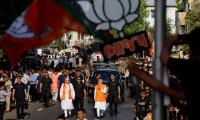The International Women’s Day campaign has chosen the theme #ChooseToChallenge for 2021, with the concept that if we challenge ourselves, if we challenge our ideas, individually taking responsibility for our own thoughts and actions, we change the world for better. “We can all choose to challenge and call out gender bias and inequality,” the campaign declared. “We can all choose to seek out and celebrate women’s achievements. Collectively, we can all help create an inclusive world.”
But inclusivity is not just about gender equality and moral values. It is also simply good economic policy. There is considerable empirical data that concludes that women’s economic empowerment boosts productivity, increases economic diversification and income equality. In addition to economic returns, female employment has positive development spillover effects: households invest more in health and education, and women being paid for work have a “voice” at home and stronger engagement in society. In Bangladesh’s garment industry, as female employment increased, the many impacts recorded include reduced fertility, increased age at marriage, and higher educational attainment. As Pakistan comes off of an economic contraction for the first time in almost 70 years, it needs all the help it can get in terms of getting its economy growing again. And women will be a key partner in this effort.
A 2018 IMF report suggests that closing the gender gap could increase GDP growth in Pakistan by 30 percent. That’s almost a third of the economy. The McKinsey Global Institute estimates that if women’s participation in Pakistan’s economy were fully equal to men’s participation, it could add as much as 60 percent to our GDP by 2025. In US dollar terms, that is about 251 billion USD!
Despite the benefits that have been documented now for years, only 13.5 million women are employed in Pakistan, which amounts to 25% of the adult female population. This is low even compared to our South Asian neighbors-according to the World Bank, the female labor force participation rate for Bangladesh and Sri Lanka is 36% and for Bhutan as high at 56%. Globally, the average female participation rate in 47.8%. Of the women employed in Pakistan, 67% are employed in the agriculture, forestry, fishing and hunting sector. In line with this statistic, employment numbers for women in rural areas far exceed those in urban areas. According to the World Bank’s note on Female Labor Force Participation women in the labor force also remain primarily involved in low-paid and low-skilled work. While the proportion of women with no education has declined from 2/3rd to little more than half the adult female population in the last two decades, over 50% of women remain engaged in unpaid work.
The meeting of G7 Ministers and Central Bank Governors in June 2018 concluded that “Despite progress, women and men do not have the same opportunities to participate in economic activity, and when women do participate, they do not receive the same recognition, wages, or benefits as men. The World Economic Forum estimates that at the current rate of progress it will take 217 years to close the overall global gender gap in female labor force participation and equal opportunities.”
Two more centuries of inequality just makes no sense, does it? And we have an opportunity to change that current rate of progress. The Covid19 pandemic has hurt the most vulnerable among us, and it disproportionately hurt women businesses. But this pandemic has also triggered digitization in a manner that many couldn’t even have dreamt of. We need to take advantage of this transformation of the traditional economic structures and make sure we come out the other side having created a more inclusive economy.
There are numerous efforts under way in Pakistan, both in the public and development sectors to ensure we do just that. The revised National Financial Inclusion Strategy (NFIS) envisions 20 million digital transaction accounts for women by 2023. Most recently the State Bank unveiled its Banking on Equality policy, which seeks to motivate financial service providers to adopt a mainstreaming lens and start deliberately targeting women consumers through their products and marketing strategies. This policy comes at a very favorable time when Raast, the country’s interoperable instant payment system has just been launched as a joint effort by State Bank and Karandaaz, which aims to revolutionize the way payments are done. At the same time, Ehsaas has initiated work on providing mobile wallets to its beneficiaries, to be followed by other account options in the future. The three initiatives happening simultaneously are expected to boost account ownership among women of all income segments, and enable them to start using greater number of financial products and services.
In addition, with funding from UKAid and the Bill & Melinda Gates Foundation, Karandaaz has been running programs with specific focus on women entrepreneurs and the financial inclusion of women. Of these, Women Ventures (WV) has invested in 18 businesses during the past 3 years, which generate more than 700 million PKR in revenue. In the wake of the pandemic, women businesses have also been provided with support to retain employees and terms for delayed repayment of loans. Karandaaz also supports gender inclusive growth through a strategic investment in the Pakistan Microfinance Investment Company (PMIC), which has more than 50 percent female clients.
While these initiatives are encouraging, Pakistan still has a long way to go. We not only need organizations like Karandaaz that focus on gender inclusivity, we need all leaders, policy makers and organizations in Pakistan to challenge themselves, be more alert, and root out gender biases from within. So this International Women’s Day, lets choose to challenge ourselves to transform. Let us not leave nearly half of our population, which means half of our creativity, half of our innovation capacity, and half of our ingenuity out of our workforce. Let’s not waste this tremendous opportunity to restructure our economy through digitization, to be more inclusive and resultantly more prosperous. Like I said, gender inclusivity is simply just good economic policy.
Writer is the CEO of Karandaaz Pakistan.
A representational image shows a person holding a cigarette between the fingers. — AFP/FileIslamabad:An increase of...
Descon Engineering Qatar LLC building seen in this undated photo.— Facebook@DesconQatarLLCIslamabad: The leader in...
Pakistan National Council of the Arts building can be seen in this image. — Radio Pakistan/FileIslamabad:The...
Officials pose for a photo during a visit to Islamabad Traffic Police Office on May 6, 2024. — Facebook/Islamabad...
Federal Minister for Communications, Privatisation & Investment Board Abdul Aleem Khan inspects the damage caused by...
Chairman of the Capital Development Authority Chaudhry Muhammad Ali Randhawa chairs a meeting on May 6, 2024. —...







